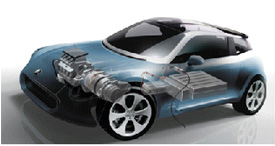Apr 29 2010
At Chinaplas 2010 in booth W2G41, SABIC Innovative Plastics announced a new portfolio of advanced Noryl* and Valox* automotive resins designed to help customers create alternative power train solutions by displacing weight and increasing performance for hybrid, plug-in hybrid (PHEV), and battery electric vehicles (BEV).
This announcement clearly answers the call to cut fossil fuel consumption and greenhouse gas emissions worldwide in favor of cleaner, better and more economical and environmentally responsible propulsion systems. In addition to helping usher in a new era of greener powertrain technologies, SABIC Innovative Plastics’ new materials offer OEMs superior impact strength, toughness, high-temperature resistance and other high-performance properties vs. competitive materials to give these manufactures a huge edge in the high-stakes global automotive arena.
 Plug-in Hybrid Vehicle (PHEV)
Plug-in Hybrid Vehicle (PHEV)
“When automotive OEMs need innovative thermoplastic solutions, they know they can look to us for support,” said V. Umamaheswaran (UV), director of Products and Marketing, SABIC Innovative Plastics, Automotive. “Environmentally progressive hybrid electric vehicles are projected to capture a significant share of the global automotive industry by 2015, and we are committed to helping our automotive customers find precise solutions to make their alternative powertrain technologies successful. As more of our customers enter this space, they can have the confidence to know that SABIC Innovative Plastics stands ready to assist in the development of the highest performing materials to help drive forward their new technology platforms.”
New Solutions for Hybrid Electric and Battery Electric Vehicle Challenges
Although hybrid, plug-in hybrid, and battery electric vehicles can reduce fuel consumption and emissions, the additional weight of battery packs – up to 300 kg (approx. 661 lbs.) on a mid-sized car – can undermine environmental benefits. To reduce weight, plastics can replace steel in different applications such as battery housings, an approach that is already being taken with leading auto manufacturers. Noryl polyphenylene oxide (PPO) and Valox polybutadiene terephthalate (PBT) resins from SABIC Innovative Plastics are excellent choices for battery components, including frames and housings. These resins also offer significant weight reduction, chemical and temperature resistance, dimensional stability and flame retardance.
Dimensional Stability Under Demanding Requirements
Unlike traditional automotive lead-acid batteries, new higher energy density battery packs are composed of many separate battery cells – up to 200 in some cases – and the structure around these cells and their electronic control systems must maintain stringent dimensional stability. With so many stacked components in limited spaces, even a little instability could potentially cause misfits, leakage or possible damage due to limited clearances.
SABIC Innovative Plastics’ Noryl and Noryl GTX* resins offer lower initial mold shrink and warp; lower moisture uptake that minimizes dimensional and mechanical property changes; and a lower and more stable coefficient of thermal expansion (CTE). These high-end properties help keep the performance of the battery pack system stable regardless of potential changes in environment such as temperature, humidity, and load.
Noryl resin is an amorphous polymer that can maintain its stiffness across a broad temperature range. This ensures better dimensional stability without the use of glass or other fillers that are needed in crystalline resins like polyamides, which may result in dimensional control issues of a part due to anisotropic shrink/growth. Uniquely, the cost-effective Noryl resin family can provide these benefits without compromising chemical resistance to common battery coolant fluids such as ethylene glycol.
Solutions for Unique Electric and Hybrid Electric Vehicle Problems
Battery electric vehicles are also becoming more and more attractive with the advancement of new lithium ion and lithium polymer batteries that have higher power and energy density. In general, batteries operate best at controlled temperatures, requiring vital temperature management of the battery packs. To cool them, liquid cooling often replaces air-cooling for greater efficiency. As a result, these liquids require chemically resistant, high-performance engineering thermoplastic materials. Further, if power is withdrawn from a battery, it will heat up – thus requiring materials with appropriate heat resistance.
SABIC Innovative Plastics offers a number of materials with these properties, including Ultem* polyetherimide (PEI) resin with high heat resistance and inherent flame retardance, and Valox PBT resin with high heat and chemical resistance. In HEVs, the higher the voltage, the more important electromagnetic interference/radio frequency interference (EMI/RFI) shielding becomes to control the potential interference from the different electronic components such as inverters, electronic control units and battery management system. LNP* Faradex* compounds from SABIC Innovative Plastics provide exceptional EMI/RFI shielding properties without the heavy weight of metal layers or the environmental risks of metallization.